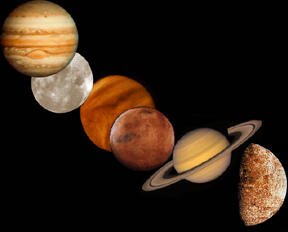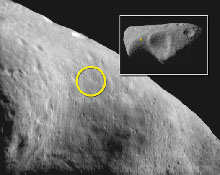This image shows where NEAR will attempt to touchdown on the surface of Eros. The yellow circle is the touchdown area.
Click on image for full size
Courtesy of NASA/JHUAPL (John Hopkins University, Applied Physics Laboratory
NEAR to Touchdown on Surface of Asteroid!
News story originally written on February 2, 2001
The NEAR spacecraft has been in orbit around the
asteroid Eros
since Valentine's Day of last year. It has met all of its science goals. It has been a huge success!
On top of all that, NEAR will attempt to go where no spacecraft has ever gone before -- on February 12, 2001, NEAR will attempt to land on Eros!
Is this a risk? Sure is! NEAR will be over 196 million miles from Earth when touchdown occurs. The main goal will be for NEAR to collect close-up pictures of the surface of Eros before it lands. It could actually take pictures of surface features about 4 inches across. That sure is close-up! But, scientists have no idea whether or not NEAR will be functional after landing. If the sequence of engine thrusts doesn't go just right, NEAR could be smashed to pieces! But, scientists do hope that NEAR will be brought down softly enough to at least be able to receive a signal from the spacecraft.
NEAR will begin its descent at 10:31 a.m. EST on February 12th. After a series of engine firings, landing is expected just after 3 p.m. EST. Stay tuned for more news on this exciting mission!
You might also be interested in:

It was another exciting and frustrating year for the space science program. It seemed that every step forward led to one backwards. Either way, NASA led the way to a great century of discovery. Unfortunately,
...more
The Space Shuttle Discovery lifted off from Kennedy Space Center on October 29th at 2:19 p.m. EST. The weather was great as Discovery took 8 1/2 minutes to reach orbit. This was the United States' 123rd
...more
A moon was discovered orbiting the asteroid, Eugenia. This is only the second time in history that a satellite has been seen circling an asteroid. A special mirror allowed scientists to find the moon
...more
Will Russia ever put the service module for the International Space Station in space? NASA officials want an answer from the Russian government. The necessary service module is currently waiting to be
...more
A coronal mass ejection (CME) happened on the Sun early last month. The material that was thrown out from this explosion passed the ACE spacecraft. The SWICS instrument on ACE has produced a new and very
...more
J.S. Maini of the Canadian Forest Service called forests the "heart and lungs of the world." This is because forests filter air and water pollution, absorb carbon dioxide, release oxygen, and maintain
...more
In late April through mid-May 2002, all five naked-eye planets are visible at the same time in the night sky! This is includes Mercury which is generally very hard to see. You won't want to miss this!
...more















